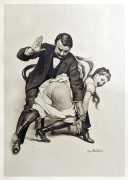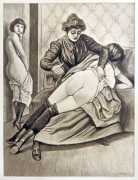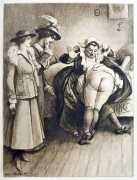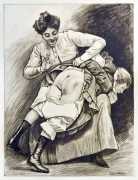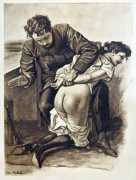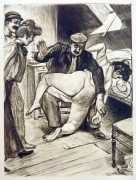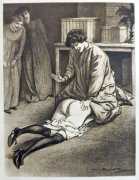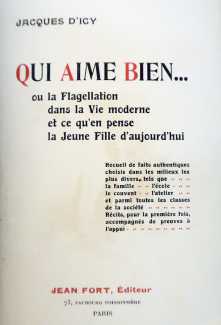 Qui aime bien … ou la flagellation dans la vie moderne et ce qu’en pense la jeune fille d’aujourd’hui (Who Loves Dearly … or flagellation in modern life and what the young girl of today thinks about it) was Malteste’s first – and very successful – outing as both author and illustrator of this classic of spanking literature, of which first editions like this are exceedingly rare. The effusive title page goes on to explain that this is ‘A collection of authentic facts chosen from the most diverse environments, including the family, the school, the convent, the workshop, and from all classes of society; for the first time these accounts are accompanied by proof of their authenticity’. The introduction goes on to describe the book as ‘masterfully designed and magnificently illustrated, a strange work, and the most remarkable of all those written up until now about flagellation’. Malteste was certainly not backward in promoting his joint production with Jean Fort. For the texts Malteste chose the pseudonym Jacques d’Icy.
Qui aime bien … ou la flagellation dans la vie moderne et ce qu’en pense la jeune fille d’aujourd’hui (Who Loves Dearly … or flagellation in modern life and what the young girl of today thinks about it) was Malteste’s first – and very successful – outing as both author and illustrator of this classic of spanking literature, of which first editions like this are exceedingly rare. The effusive title page goes on to explain that this is ‘A collection of authentic facts chosen from the most diverse environments, including the family, the school, the convent, the workshop, and from all classes of society; for the first time these accounts are accompanied by proof of their authenticity’. The introduction goes on to describe the book as ‘masterfully designed and magnificently illustrated, a strange work, and the most remarkable of all those written up until now about flagellation’. Malteste was certainly not backward in promoting his joint production with Jean Fort. For the texts Malteste chose the pseudonym Jacques d’Icy.
‘Qui aime bien’ is the first part of a well-known French saying, ‘Qui aime bien châtie bien’ (‘those who love dearly punish well’, the French equivalent of ‘spare the rod and spoil the child’), so the connection with flagellation is crystal clear. The sequel to Qui aime bien, Châtie bien, appeared a year later.
Qui aime bien was remarkably successful. After the first printing of just 200 copies, it was reprinted in 1916, 1919, 1920, 1927 and 1937, with its final appearance in print being as late as 1978 by the erotica publisher Dominique Leroy.
Among other attributes, it is probably Malteste’s decision to include a wide variety of spanking scenarios, and not just standard schoolgirl fare, which contributed to the long-lived success of Qui aime bien.



